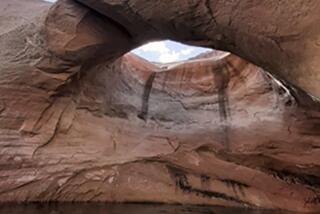Ancient Persian Arch Becomes Casualty of War in Iraq
- Share via
CTESIPHON, Iraq — During its heyday two millenniums ago, the Roman emperor Julian II was so entranced by the architecture of the Persian capital of Ctesiphon that he ordered his legions to leave it alone.
Two decades ago, President Saddam Hussein added his own grandiose touches to the ruins of Ctesiphon--which is pronounced TES-eh-fahn--seeking to rekindle enthusiasm for the site about 30 miles south of Baghdad.
Today, like everything else in Iraq, ancient Ctesiphon and the monuments Hussein built are crumbling.
Living under U.N. trade sanctions imposed after Hussein’s 1990 invasion of Kuwait, Iraqis can barely afford such basics as food and medicine. Maintaining their cultural heritage is a luxury.
As a result, the world is on the verge of losing Ctesiphon’s main architectural wonder--the arch of King Sapor’s great banqueting hall first built in the 3rd century B.C. and rebuilt in the 6th century A.D. by King Chosroes I.
Muayad Saaeed, head of the Iraqi Antiquities Department, said the 82-foot-wide, 99-foot-high arch is the widest and highest single span of brickwork in the world.
Local tradition has it that the moment Islam’s Prophet Mohammed was born in the 6th century, the arch cracked. Today it is not only cracking, but sinking because of rising ground water. Bricks are falling and the foundations of the 23-foot brick walls supporting the arch could crumble any time.
“It could fall if not immediately rescued,” said Abbas Fadhil, the archeologist in charge of Ctesiphon.
The arch and the walls of the banquet hall are the only survivors of Ctesiphon’s past splendor. The rest is a mass of dunes, some small and some large.
From time to time, people from nearby towns and villages dig up the dunes to retrieve ancient bricks for use in modern dwellings. Fadhil said the bricks are stronger than any made today.
Ctesiphon was built on the opposite side of the Tigris from Seleucia, the capital of Seleucus, named for a Macedonian general who founded a dynasty in Iraq in the 3rd century B.C.
The city prospered under Chosroes, the Persian king who rebuilt the arch. The Ctesiphon of Chosroes’ day had a university, a chess club and a translation academy.
Ctesiphon and Seleucia were joined by a bridge. The Arabs who conquered the region in 637 called them jointly al-Madain, the Two Cities. Al-Madain is perhaps the most famous ancient site in Mesopotamia after Ur and Babylon.
Hussein recently earmarked $5,500 for a survey to see what needs to be done to save Ctesiphon’s remnants. Iraqi engineers are taking soil and water samples to prepare recommendations on how to preserve the arch. Saaeed could not say how much restoration might cost.
In the early 1980s, Hussein ordered the construction of a panorama in the shape of a terraced Mesopotamian ziggurat to commemorate a 7th-century battle in which Arabs defeated a Persian army. Dozens of North Korean artists painted battle scenes on a 16,000-square-foot screen that Fadhil said was the third largest in the world.
Hussein also constructed a hotel, a restaurant, a swimming pool and an extensive garden.
Residents of Baghdad once came to picnic at Ctesiphon, but its green lawns and palm trees are withered now.
Visitors viewing the giant panorama cannot hear the clatter of armor, shouting of warriors and neighing of war horses meant to accompany it--the sound system no longer functions due to lack of spare parts and electricity.
More to Read
Sign up for Essential California
The most important California stories and recommendations in your inbox every morning.
You may occasionally receive promotional content from the Los Angeles Times.










